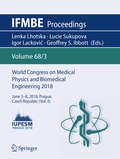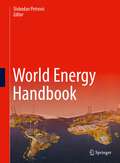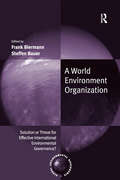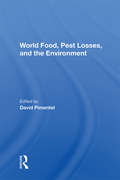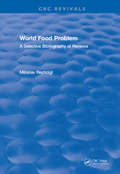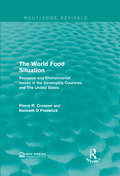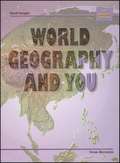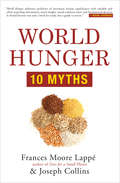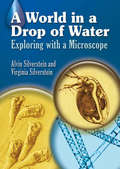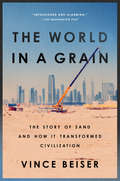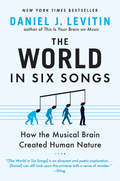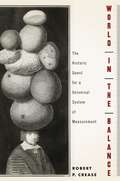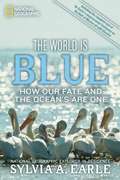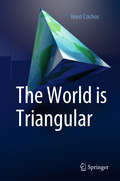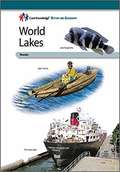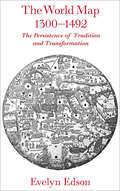- Table View
- List View
World Congress on Medical Physics and Biomedical Engineering 2018: June 3-8, 2018, Prague, Czech Republic (vol. 2) (IFMBE Proceedings #68/2)
by Lenka Lhotska Lucie Sukupova Igor Lacković Geoffrey S. IbbottThis book (vol. 3) presents the proceedings of the IUPESM World Congress on Biomedical Engineering and Medical Physics, a triennially organized joint meeting of medical physicists, biomedical engineers and adjoining health care professionals. Besides the purely scientific and technological topics, the 2018 Congress will also focus on other aspects of professional involvement in health care, such as education and training, accreditation and certification, health technology assessment and patient safety. The IUPESM meeting is an important forum for medical physicists and biomedical engineers in medicine and healthcare learn and share knowledge, and discuss the latest research outcomes and technological advancements as well as new ideas in both medical physics and biomedical engineering field.
World Cultures and Geography
by Sarah Witham Bednarz Ines M. Miyares Mark C. Schug Charles S. WhiteThis textbook contains unit lessons on Introduction to World Cultures and Geography, The United States and Canada, Latin America, Europe, Russia, and the Independent Republics, North Africa and Southwest Asia, Africa South of the Sahara, Southern Asia, East Asia, Australia, Oceania, and Antarctica. The book includes the biographies of nineteen eminent personalities.
World Energy Handbook
by Slobodan PetrovicWorld Energy Handbook presents an overview of the energy systems of selected countries in Africa, Asia, the Americas, and Europe. It is a complete guide to energy history and generation in these countries, including renewable energy, storage, and use. The authors follow the same analytical approach for each country to construct comprehensive surveys of all aspects of energy systems, examining the advantages and disadvantages of each country’s energy infrastructures. The handbook aims to raise awareness about the condition and deficiencies of energy systems in developing countries, and the potential for the countries to improve, grow, and advance the technologies for energy generation – especially by turning to renewable energy sources to increase energy storage capacities and optimizing the way subsystems are integrated. The book serves as a must-have guide for decision-makers, investors, business people, and other professionals to understand the global distribution of energy generation, transmission, and each country’s carbon footprint and identify opportunities for energy system improvement worldwide.
A World Environment Organization: Solution or Threat for Effective International Environmental Governance? (Global Environmental Governance)
by Frank BiermannIn recent years, the debate on the establishment of a new international agency on environmental protection - a 'World Environment Organization' - has gained substantial momentum. Several countries, including France and Germany, as well as a number of leading experts and senior international civil servants have openly supported the creation of such a new international organization. However, a number of critics have also taken the floor and brought forward important objections. This book presents a balanced selection of articles of the leading participants in this debate, including both major supporters and opponents of creating a World Environment Organization. The volume is especially relevant to students and scholars of international relations, environmental policy and international law, as well as to practitioners of diplomacy, international negotiations, and environmental policy making.
World Explorer: Tools and Concepts
by Heidi Hayes Jacobs Michal L. LevasseurLearning about geography tools and concepts means being an explorer, and no explorer would start out without first checking some facts. Use the activities on the following page to begin exploring the world of geography. They will help you learn what geography is and how it can help you.
World Food, Pest Losses, And The Environment
by David PimentelThis book focuses on current food shortages and on the impact of pests in reducing world food supplies. At present, total worldwide food losses from pests are estimated to be about 45 percent. Preharvest losses alone, from insects, plant pathogens, and weeds, are estimated at about 30 percent. Additional postharvest losses from microorganisms, insects, and rodents range from about 10 to 20 percent. The contributors present data on the extent of these kinds of crop losses and analyze immediate and long-term pest management strategies. Emphasis is given to an evaluation of the effectiveness of integrated controls and the various new nonchemical pest controls used to reduce crop and livestock losses. The current worldwide environmental problems associated with both large-scale pesticide use and other pest control methods are also analyzed, including the impact that increased use of pesticides can be expected to have on the human environment. While the data included are technical, the presentation and analysis will be of interest to both the scientific community and the general public.
World Food Problem
by Professor Miloslav RechciglThe aim of this publication is to provide the interested reader with an authoritative and comprehensive up-to-date bibliography on all important facets of the world food problem, encompassing such questions as the availability of natural reseources, the present and future sources of energy, environmental quality, population growth, world malnutrition, the state of food production, food consumption patterns, future food needs, toxicological aspects of food, agricultural and industrial aspects of food production, and family planning. It is the first compilation of its kind in that it covers the subject from a multidisciplinary point of view, including publications that deal with teh description and alaysis of the world food problem as well as those that offer alternative strategies adn specific technological meaures for alleviating the problem.
The World Food Situation: Resource and Environmental Issues in the Developing Countries and The United States (Routledge Revivals)
by Pierre R. Crosson Kenneth D FrederickAt the beginning of the 1970’s, global grain reserves were level and food prices were low however as the decade progressed crop production plummeted leading to a food crisis. Originally published in the aftermath in 1977, Crosson and Frederick set out to explore the ability of agricultural output to meet the global food demands of future generations. This study analyses how resources and environmental factors would affect food production in developing countries and the United States until the end of the 21st Century. The environmental impacts of land levels, fertiliser and pesticide use are explored in relation to the challenges of meeting food demands. This title will be of interest to students of environmental studies.
World Geography: Building a Global Perspective
by Thomas J. Baerwald Celeste FraserThis program will help you learn content, develop skills, and apply what you know. Examine these pages to understand how this textbook and its online resources can guide you through the study of world geography.
World Geography
by Preston E. James Nelda DavisGo on a geographical tour around the world! Explore the world while solving the riddle using informational clues about each country. Students study 30 countries, grouped by continent, using maps, charts, graphs, puzzles, and hands-on activities.
World Geography and You: The Complete Edition
by Vivian BernsteinAs you study world geography, you will learn what the land looks like in different parts of the world. You will learn how people live in different places. You will study how people have changed the places where they live. You will also study the culture of people in different countries. Culture is the ideas, art, and way of life of a group of people. When you study about culture, you learn about food, clothing, sports, customs, and language of a group of people. Religion is also part of culture. Religion is the different ways people believe and pray to a god or to many gods.
World Geography (California Edition)
by Daniel D. Arreola Marci Smith Deal James F. Petersen Rickie SandersThis McDougal Littell California Edition of World Geography consists of reading materials on The Basics of Geography, The United States and Canada, Latin America, Europe, Russia and the Republics, Africa, Southwest Asia, South Asia, East Asia, Southeast Asia, Oceania, and Antarctica, etc.
World Geography Today
by David M. HelgrenWorld Geography Today is a guide to learning about the constantly changing world in which you live. This textbook will help you understand the study of geography and make sense of our complex world.
World Hunger: 10 Myths
by Joseph Collins Frances Moore LappéFrom bestselling authors Frances Moore Lappé and Joseph Collins comes the 21st century’s definitive book on world hunger. Driven by the question, "Why hunger despite an abundance of food?" Lappé and Collins refute the myths that prevent us from addressing the root causes of hunger across the globe. World Hunger: Ten Myths draws on extensive new research to offer fresh, often startling, insights about tough questions-from climate change and population growth to genetically modified organisms (GMOs) and the role of U.S. foreign aid, and more.Brimming with little-known but life-changing examples of solutions to hunger worldwide, this myth-busting book argues that sustainable agriculture can feed the world, that we can end nutritional deprivation affecting one-quarter of the world’s people, and that most in the Global North have more in common with hungry people than they thought. For novices and scholars alike, World Hunger: Ten Myths will inspire a whole new generation of hunger-fighters.
A World in a Drop of Water: Exploring with a Microscope (Dover Children's Science Books)
by Alvin Silverstein Virginia SilversteinThis inexpensive volume showcases an array of curious creatures: a blob-like amoeba; a slipper-shaped paramecium and its mortal enemy, the suctorian; and many others. The authors recount the feeding, reproductive, and defensive strategies employed by these animals in easy-to-understand language that opens the door to a wonderful world of discovery. 37 illustrations.
The World in a Grain: The Story of Sand and How It Transformed Civilization
by Vince BeiserThe gripping story of the most important overlooked commodity in the world--sand--and the crucial role it plays in our lives.After water and air, sand is the natural resource that we consume more than any other--even more than oil. Every concrete building and paved road on Earth, every computer screen and silicon chip, is made from sand. From Egypt's pyramids to the Hubble telescope, from the world's tallest skyscraper to the sidewalk below it, from Chartres' stained-glass windows to your iPhone, sand shelters us, empowers us, engages us, and inspires us. It's the ingredient that makes possible our cities, our science, our lives--and our future.And, incredibly, we're running out of it.The World in a Grain is the compelling true story of the hugely important and diminishing natural resource that grows more essential every day, and of the people who mine it, sell it, build with it--and sometimes, even kill for it. It's also a provocative examination of the serious human and environmental costs incurred by our dependence on sand, which has received little public attention. Not all sand is created equal: Some of the easiest sand to get to is the least useful. Award-winning journalist Vince Beiser delves deep into this world, taking readers on a journey across the globe, from the United States to remote corners of India, China, and Dubai to explain why sand is so crucial to modern life. Along the way, readers encounter world-changing innovators, island-building entrepreneurs, desert fighters, and murderous sand pirates. The result is an entertaining and eye-opening work, one that is both unexpected and involving, rippling with fascinating detail and filled with surprising characters.
The World in Six Songs: How the Musical Brain Created Human Nature
by Daniel J. LevitinThe author of the New York Times bestseller This Is Your Brain on Music reveals music's role in the evolution of human culture-and "will leave you awestruck" (The New York Times)Daniel J. Levitin's astounding debut bestseller, This Is Your Brain on Music, enthralled and delighted readers as it transformed our understanding of how music gets in our heads and stays there. Now in his second New York Times bestseller, his genius for combining science and art reveals how music shaped humanity across cultures and throughout history. Dr. Levitin identifies six fundamental song functions or types-friendship, joy, comfort, religion, knowledge, and love-then shows how each in its own way has enabled the social bonding necessary for human culture and society to evolve. He shows, in effect, how these "six songs" work in our brains to preserve the emotional history of our lives and species. Dr. Levitin combines cutting-edge scientific research from his music cognition lab at McGill University and work in an array of related fields; his own sometimes hilarious experiences in the music business; and illuminating interviews with musicians such as Sting and David Byrne, as well as conductors, anthropologists, and evolutionary biologists. The World in Six Songs is, ultimately, a revolution in our understanding of how human nature evolved-right up to the iPod.Read Daniel Levitin's posts on the Penguin Blog.
The World in Six Songs: How the Musical Brain Created Human Nature
by Daniel J. LevitinThe author of the New York Times bestseller This Is Your Brain on Music reveals music's role in the evolution of human culture-and "will leave you awestruck" (The New York Times)Daniel J. Levitin's astounding debut bestseller, This Is Your Brain on Music, enthralled and delighted readers as it transformed our understanding of how music gets in our heads and stays there. Now in his second New York Times bestseller, his genius for combining science and art reveals how music shaped humanity across cultures and throughout history. Dr. Levitin identifies six fundamental song functions or types-friendship, joy, comfort, religion, knowledge, and love-then shows how each in its own way has enabled the social bonding necessary for human culture and society to evolve. He shows, in effect, how these "six songs" work in our brains to preserve the emotional history of our lives and species. Dr. Levitin combines cutting-edge scientific research from his music cognition lab at McGill University and work in an array of related fields; his own sometimes hilarious experiences in the music business; and illuminating interviews with musicians such as Sting and David Byrne, as well as conductors, anthropologists, and evolutionary biologists. The World in Six Songs is, ultimately, a revolution in our understanding of how human nature evolved-right up to the iPod.Read Daniel Levitin's posts on the Penguin Blog.
The World in Six Songs: How the Musical Brain Created Human Nature
by Daniel J. LevitinThe author of the New York Times bestseller This Is Your Brain on Music reveals music's role in the evolution of human culture-and "will leave you awestruck" (The New York Times)Daniel J. Levitin's astounding debut bestseller, This Is Your Brain on Music, enthralled and delighted readers as it transformed our understanding of how music gets in our heads and stays there. Now in his second New York Times bestseller, his genius for combining science and art reveals how music shaped humanity across cultures and throughout history. Dr. Levitin identifies six fundamental song functions or types-friendship, joy, comfort, religion, knowledge, and love-then shows how each in its own way has enabled the social bonding necessary for human culture and society to evolve. He shows, in effect, how these "six songs" work in our brains to preserve the emotional history of our lives and species. Dr. Levitin combines cutting-edge scientific research from his music cognition lab at McGill University and work in an array of related fields; his own sometimes hilarious experiences in the music business; and illuminating interviews with musicians such as Sting and David Byrne, as well as conductors, anthropologists, and evolutionary biologists. The World in Six Songs is, ultimately, a revolution in our understanding of how human nature evolved-right up to the iPod.Read Daniel Levitin's posts on the Penguin Blog.
World in Six Songs, The
by Levitin Daniel J.The author of the New York Times bestseller This Is Your Brain on Music reveals music's role in the evolution of human culture-and "will leave you awestruck" (The New York Times) Daniel J. Levitin's astounding debut bestseller, This Is Your Brain on Music, enthralled and delighted readers as it transformed our understanding of how music gets in our heads and stays there. Now in his second New York Times bestseller, his genius for combining science and art reveals how music shaped humanity across cultures and throughout history. Dr. Levitin identifies six fundamental song functions or types-friendship, joy, comfort, religion, knowledge, and love-then shows how each in its own way has enabled the social bonding necessary for human culture and society to evolve. He shows, in effect, how these "six songs" work in our brains to preserve the emotional history of our lives and species. Dr. Levitin combines cutting-edge scientific research from his music cognition lab at McGill University and work in an array of related fields; his own sometimes hilarious experiences in the music business; and illuminating interviews with musicians such as Sting and David Byrne, as well as conductors, anthropologists, and evolutionary biologists. The World in Six Songs is, ultimately, a revolution in our understanding of how human nature evolved-right up to the iPod. Read Daniel Levitin's posts on the Penguin Blog.
World in the Balance: The Historic Quest for an Absolute System of Measurement
by Robert P. CreaseThe epic story of the invention of a global network of weights, scales, and instruments for measurement. Millions of transactions each day depend on a reliable network of weights and measures. This network has been called a greater invention than the steam engine, comparable only to the development of the printing press. Robert P. Crease traces the evolution of this international system from the use of flutes to measure distance in the dynasties of ancient China and figurines to weigh gold in West Africa to the creation of the French metric and British imperial systems. The former prevailed, with the United States one of three holdout nations. Into this captivating history Crease weaves stories of colorful individuals, including Thomas Jefferson, an advocate of the metric system, and American philosopher Charles S. Peirce, the first to tie the meter to the wavelength of light. Tracing the dynamic struggle for ultimate precision, World in the Balance demonstrates that measurement is both stranger and more integral to our lives than we ever suspected.
The World Is Blue: How Our Fate and the Ocean's Are One
by Sylvia A. EarleExplorer-in-residence at the National Geographic Society, oceanographer Earle adds blue to the green movement by explaining the importance of the earth's ocean to the health of its life. She begins by setting out the conventional vision of the ocean's limitless bounty for harvesting wildlife and infinite resiliency as the ultimate garbage disposal. Then she explains how the ocean is suffering from biodiversity loss, drilling, mining, shipping, spilling, and changing climate and chemistry. The final section surveys opportunities for reversing the tide by exploring and governing the ocean, smart aquaculture, and protective measures. Annotation c2009 Book News, Inc., Portland, OR (booknews.com)
The World is Triangular
by Horst CzichosThis book gives a short presentation of the triad philosophy–physics–technology against the background of the common origin in ancient times. The emergence of the book has been described in the foreword of the first edition. The present second edition of the book is updated and extended, whereby new physical research results and technological innovations were included: - The physics of space and time after the experimental detection of gravitational waves (Nobel Prize for Physics 2017). - The New International System of Units (SI) for Physics and Technology which is completely based on natural constants and entered into force on World Metrology Day, 20 May 2019. - Actual overview of basic technologies: Material, Energy, Information. - Technologies for the “Digital World” of information and communication. - Mechatronic and Cyber-physical systems for Industry 4.0. The significance of technology for the world in the 21st century is discussed in the final section of the book.
World Lakes (Core Knowledge History and Geography)
by Core Knowledge FoundationWORLD LAKES begins with a review of map skills and geographical terms. Students learn about the benefits and resources provided by lakes, including, in Asia, the Caspian and Aral Seas; in Africa, Lakes Victoria, Tanganyika, and Chad; in South America, Lakes Maracaibo and Titicaca; and, in North America, Lakes Superior, Huron, Michigan, Erie, and Ontario.
The World Map, 1300–1492: The Persistence of Tradition and Transformation
by Evelyn EdsonA history of the development of world maps during the later medieval period in the centuries leading up to Columbus’s journey.In the two centuries before Columbus, mapmaking was transformed. The World Map, 1300–1492 investigates this important, transitional period of mapmaking. Beginning with a 1436 atlas of ten maps produced by Venetian Andrea Bianco, Evelyn Edson uses maps of the fourteenth and fifteenth centuries to examine how the discoveries of missionaries and merchants affected the content and configuration of world maps.She finds that both the makers and users of maps struggled with changes brought about by technological innovation?the compass, quadrant, and astrolabe?rediscovery of classical mapmaking approaches, and increased travel. To reconcile the tensions between the conservative and progressive worldviews, mapmakers used a careful blend of the old and the new to depict a world that was changing?and growing?before their eyes.This engaging and informative study reveals how the ingenuity, creativity, and adaptability of these craftsmen helped pave the way for an age of discovery.“A comprehensive and complex picture of the changing face of medieval geography. With the mastery of a formidable palette of historiographic knowledge and well-reasoned discussions of the sources, The World Map, 1300–1492 will certainly remain an important work to consult for both medieval and early modern scholars for many years to come.” —Ian J. Aebel, Terrae Incognitae
